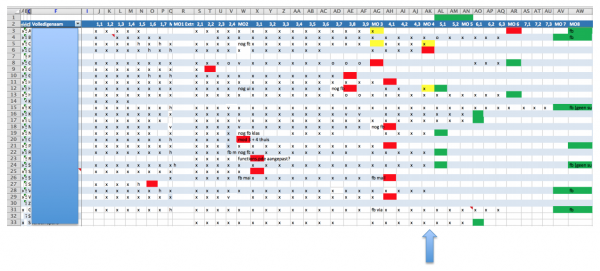Difference between revisions of "Preparation Status Awareness/alx"
Sfrancisco (talk | contribs) (Added contributors) |
Sfrancisco (talk | contribs) (Added category) |
||
| (One intermediate revision by the same user not shown) | |||
| Line 58: | Line 58: | ||
<references/> | <references/> | ||
[[Category:Design_patterns]] <!-- List of other categories the design pattern belongs to. The syntax for linking to a category is: [[Category:<Name of category]] --> | [[Category:Design_patterns]] [[Category:Full_Pattern]] [[Category:Flipped Classroom Patterns]] [[Category:Traditional Classroom]]<!-- List of other categories the design pattern belongs to. The syntax for linking to a category is: [[Category:<Name of category]] --> | ||
Latest revision as of 11:55, 16 May 2017
| Preparation Status Awareness | |
| Contributors | Christian Köppe, Ralph Niels, Robert Holwerda, Lars Tijsma, Niek Van Diepen, Koen Van Turnhout, René Bakker, Stijn Hoppenbrouwers |
|---|---|
| Last modification | May 16, 2017 |
| Source | Köppe et al. (2015)[1]; Köppe et al. (2016)[2] |
| Pattern formats | OPR Alexandrian |
| Usability | |
| Learning domain | |
| Stakeholders | |
Your course is running. You’re doing a Preparation Material Check (Preparation Material Check) before each in-class meeting and observe that differences in the level of preparations start to emerge.
Over time, students become less and less motivated to prepare for class. This leads to an increase of differences in knowledge levels at the start of the next class which in consequence makes it harder to offer valuable in-class meetings to all students.
In many student classes, group dynamics can make statements like “no one else did the homework, so why should I do it?" emerge.
And even if students see that other students prepared for class, they might become less motivated to do it themselves if they have the feeling that no one cares about whether they prepared or not. This is especially true for students who only recently started their higher education, and are still discovering what learning consists of and what their responsibilities are.
Therefore: Show the students (publicly) that you are aware of the status of their preparations in order to encourage them to prepare each meeting. Appreciate the ones that are on schedule and encourage the ones that run behind.
The most straightforward way of keeping track of the students’ status is by having a table with all students in one dimension and all required preparations—handed in homework, solved quizzes etc.—in the other dimension, and the status of the preparation in the cells, such as can be see in the figure below. This table needs to be maintained, which requires some additional effort, but can easily be used for showing the status awareness, either to the individual student or the whole group.
A variant of the solution is to quickly let students know that the handed-in preparation was received, e.g. by sending a short reply with “Thank you for handing in your work.". This way the students also know that the teacher is aware of their preparations, even though there won’t be a complete overview as with the table. This approach takes more time to apply, especially with larger groups. If not much time is available, it might still be valuable to at least occasionally reply to students, preferably at least once for all students.
Showing students that you are aware of their preparation status clearly communicates that you do care about their learning, which is motivating for them.
However, some students might feel offended or be embarrassed when they haven’t made all preparations and their preparation status is publicly exposed (as on a “wall of shame"). This is especially true if the students have good reasons for it like illness or if they tried to make the preparations and got stuck. In that case it should explicitly not be used for blaming the students, but rather for asking them why they haven’t made the preparations and how you as a teacher can help them. As the goal is to encourage the students to prepare for each meeting, the emphasis should be primarily on the students who have prepared by giving them positive feedback and recognition. It should furthermore be emphasized that by doing the preparations for class the students learn the most and increase the chance of passing the course with a good grade.
If necessary, such a list as shown in the figure below could be semi-anonymized by showing only student IDs or (self-chosen) acronyms instead of full names.
This pattern is related to Every Student Solution Counts (Every Student Solution Counts), in which the teacher makes sure that preparations of all students are used as an example every once in a while.
In the course on Object-Oriented Program Development at HAN University, the students had to send their preparations by email prior to class. At the beginning of each in-class meeting, the lecturer opened the mailbox and scanned through all received emails, hereby also identifying the students who haven’t handed in their work directly
Another example application of this pattern is a spread-sheet from a lecturer that shows the status of delivered homework and also indicates who’s running behind and who is on scheme (even made more explicit by the use of traffic light colors green, yellow and red). The arrow in the figure above indicates the moment of the course, also making clear where students are expected to be according to the schedule.
References
- ↑ Patlet first mentioned in Köppe, C., Niels, R., Holwerda, R., Tijsma, L., Van Diepen, N., Van Turnhout, K., Bakker, R., (2015). Flipped Classroom Patterns - Designing Valuable In-Class Meetings. In Proceedings of the 20th European Conference on Pattern Languages of Programs (EuroPLoP 2015). New York:ACM.
- ↑ Pattern first published in Köppe, C., Niels, R., Bakker, R., & Hoppenbrouwers, S. (2016). Flipped Classroom Patterns-Controlling the Pace. In Proceedings of the 10th Travelling Conference on Pattern Languages of Programs (VikingPLoP 2016). New York:ACM.
